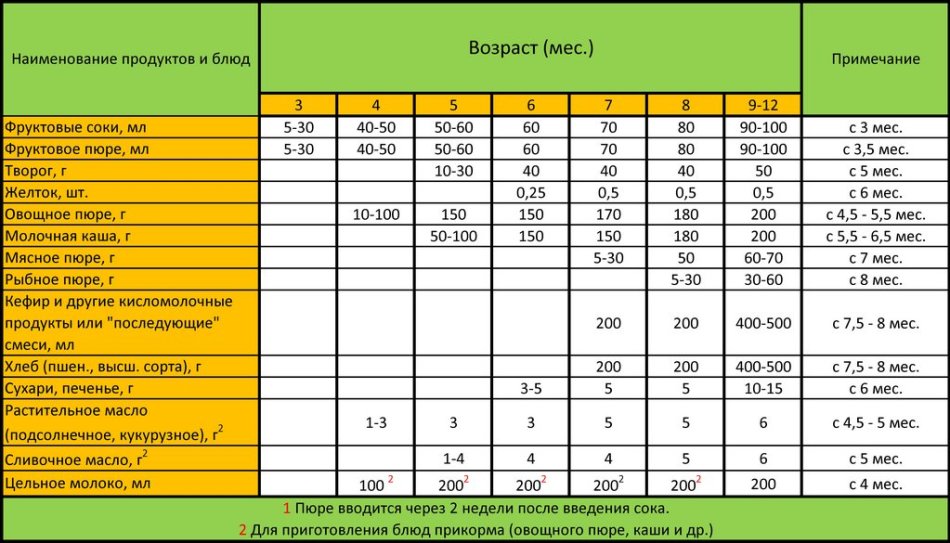Content
- Proper feeding of a child for months up to a year
- Video: “The baby is feeding. Where to begin? How to feed? When?"
- Detailed feeding for months with breastfeeding: Table
- Video: "Breast feeding should be supplemented with complementary foods?"
- Safe feeding for months with artificial feeding: Table
- Video: "Artificial feeding"
- Pendener diet for every month, useful tips and recommendations
- Video: "When and where to start complementary foods?"
- A menu for feeding for babies on breast and artificial feeding
- Video: “Lowering. Feeding a child for months "
Proper feeding of a child for months up to a year
- In the life of each baby, the moment comes when there is already little milk for good nutrition. The child every month is more and more active, he grows and requires more calories and nutrients
- Feeding is the introduction of new foods into the baby’s diet. It is necessary to do it correctly, given all the features of age, health and needs
- As practice shows, young children are very fond of trying “adult food”. It differs significantly from breast milk, has many taste shades and other texture
- Parents need to properly build complementary foods, observing the size and composition of portions for their child, so as not to cause him disorders, poisoning or constipation. It is important not to offer the child everything in a row, but to understand and clearly build a scheme of products that must be entered first and which

Important: the nutritional value of complementary foods perfectly complements breast milk or artificial dairy mixtures.
It is not for anyone that it is no secret that the full nutrition of the child is the basis of his health for the whole subsequent life. This is a kind of "foundation" of the baby. That is why complementary foods should be phased, smooth and diverse.
There are certain rules for the introduction of different products that should not be ignored. They are listed in special tables of complementary feeding and every responsible mother should adhere to this schedule.
Power feeding can be of plant origin:
- fruit puree
- vegetable mashed potatoes
- juices, compotes, jelly
- porridge, soups
There is also complementary foods and animal origin:
- eggs
- cottage cheese
- kefir
- dairy porridge
- meat
- fish
Feeding helps the baby from breast milk and mixtures. The fact is that such food stimulates the release of digestive enzymes, develops chewing skills and interests the child with its taste. Each mother must carefully monitor the needs and development of her child in order to understand exactly that he needs complementary foods. Such factors as:
- rejection of the child’s weight to low indicators suggests that the baby is often hungry and loses weight
- the emergence of a strong interest in what the mother eats says that the baby is tired of watching and he also wants to try such food
- the baby’s capricious behavior after milk feeding says that he remains hungry and such food is not enough for him to saturate

These factors can appear at any age, but most often they begin to appear after four months. However, pediatrician and experienced specialists strongly recommend complementing complementary foods when the child is reached.
This recommendation is relevant for those women who have a sufficient amount of breast milk. In other cases, when the child is artificial feeding, he may require feeding a little earlier than six months.
It is impossible to rush to feed the baby with “adult food” because it is not always able to have a favorable effect. This happens because the children's digestive system turns out to be unusual for heavy and unusual food. That is why you can observe such phenomena as liquid and frequent stools, vomiting and regurgitation, fever, colic in intestines and abundant gas formation.
Video: “The baby is feeding. Where to begin? How to feed? When?"
Detailed feeding for months with breastfeeding: Table
The correct start of feeding will provide your baby with smooth introduction into adult food and create a minimum of health problems. Doctors recommend starting complementary foods with a spoon. It is the spoon that weanes the baby from the chest or nipples, that is, it forms the skills of proper eating behavior.
It is also useful for each mother to keep a food diary. This detail will carefully monitor what food the baby eats and how it reacts to it.

Introducing other food products into the diet of a baby, you should know all the features of his digestive system, the baby’s tendency to constipation or diarrhea. All because different food causes different reactions. For example, rice porridge fastenes, and fiber from fruits and vegetables is slanting.
It is important to know that by starting complementary foods, the child’s chair will form and normalize only a week later, until that time you can observe impurities of mucus in the feces, which arise as a result of the production of enzymes.
The Association of World Children's Doctors came to the conclusion that the first complementary foods should include special porridge and dairy products. Concentrated juice is harmful to children under nine months. All because it contains a huge amount of acids that can harmfully affect the infant digestive system. Those juices that you give to the child should be twice and three times diluted with purified water.
Estimated scheme for entering feeding for children on breastfeeding:
 Breast milk remains the main food for babies. The breast should be given to the baby immediately after you tried to feed him other food. Be careful and the first porridge for the baby cook only on the water, without improving milk. Give preferences with white, light and greenish vegetable and fruit puree at the first feeding, they are easy for digestion.
Breast milk remains the main food for babies. The breast should be given to the baby immediately after you tried to feed him other food. Be careful and the first porridge for the baby cook only on the water, without improving milk. Give preferences with white, light and greenish vegetable and fruit puree at the first feeding, they are easy for digestion.
Important: only after two months you can begin to make peculiar mixes and multicomponent mixtures-puree. Remember that the purpose of feeding in the first months of the child’s life is not to saturate his foreign food, but to teach his digestive system to work with other products.
Video: "Breast feeding should be supplemented with complementary foods?"
Safe feeding for months with artificial feeding: Table
As mentioned earlier, children who are on artificial feeding may require feeding much earlier than those who feed breast milk. The reason for this is the fact that breast milk contains eight times more beneficial trace elements than the best milk mixture. If you notice your child’s need for complementary foods, start its correct introduction.
First of all, make sure that at the moment your baby is absolutely healthy and has no digestive disorders that can occur for various reasons: teeth, for example or colds are cut.

Do not try to give your child the maximum number of products at a time and limit the feeding maximum with one new element every day. The first complementary foods should be liquid enough for the baby to deal with him. Choose not concentrated juices or breed mashed potatoes with cleaned water.
Try to combine power with bottle milk. Offer him a spoonful of food and only then milk. During the day, do not forget to offer the child to drink water so that he does not have constipation (artificial milk is saturated with protein).

Be sure to check the baby's reaction to the product and only then try to enter a new one. Try feeding not with the vegetable, but with a fruit mixture. This will allow the baby to get the pleasure of sweet food and try to open his mouth for a spoon.
Video: "Artificial feeding"
Pendener diet for every month, useful tips and recommendations
Every month, your child will grow and his needs for more high -calorie and tasty foods will grow. In complementary foods, it is important to observe the necessary consistency for food: to start feeding with liquid, continue with puree and only then introduce a body -shaped one. This mode allows you to properly develop chewing skills and accustom the stomach to digest food.
Many products may have an allergic reaction: fruits, some vegetables or cereals. Therefore, carefully follow your child’s behavior: how he feels and what his chair is. When observing any negative reaction, limit the consumption of this product for a while.

The older the baby becomes, the more often you need to feed him throughout the day. So, the first feeding mono to carry out once a day and over time increase to three meals. Remember that the first feedings should not be plentiful and you need to start literally with a few drops of the product.

The gradual and moderate introduction of food into the diet will allow the child to form correct habits and establish a digestive system. Starting complementary foods, be sure to adhere to the table and do not forget to follow the feelings of the baby, as well as his wishes. Little children are also people and they, like adults, are able to prefer certain products and give a refusal to others.
Do not force the child to eat from the spoon if he is not ready for this yet. In any case, the interest in "adult foods" must have it, but only when there is a need for this.
Video: "When and where to start complementary foods?"
A menu for feeding for babies on breast and artificial feeding
Each mother decides for herself what food products will become the first feeding of the baby: those that are sold in the store or those that can be cooked independently. The main and basic rule that should be followed is the complete sterility of children's dishes and the naturalness of the ingredients.
Do not try to teach the baby to eat several foods at once, do not drive it and give it the opportunity to cope with minimal amounts of food. Starting complementary foods, dilute even the most liquid gruel, mashed potatoes and juices to avoid poisoning and allergic reactions.

Remember that harmful foods should not include in the diet of your baby. Even when reaching twelve months, chocolate sweets, cakes, mayonnaise, sausage, fast food and other food products are unacceptable. If you want to please it sweet, then the sweetest for him should be natural jam or jam.
Remember, complementary foods are really necessary for the child if he owns certain “adult skills. Such as:

Approximate menu for complementary foods for a child of six months:
- First week:breast milk (or mixture) and a half spoon of children's porridge (oatmeal or buckwheat), a day later you can introduce a few drops of juice or diluted puree into the diet
- Second week:breast milk (or mixture) and three teaspoons of children's porridge, vegetable mashed potatoes of white or green colors (less allergenic) - a teaspoon
- Third week:increase the number of cereals and fruit and vegetable mixtures during the day, each use of food “Wash” with milk
Video: “Lowering. Feeding a child for months "








We gave from six months freshly squeezed apple juice and fruit-vegetable purees, then all sorts of porridge. From 8 months, they accustomed to cottage cheese and kefir, they also prepared “Bakzdrav” on the sourdoughs. They immediately noticed that the baby is much easier to go to the toilet, probably fermented milk bacteria help. And then we had neither bloating nor colic, and even appetite improved, because with normal intestinal microflora, the absorption of nutrients improves.